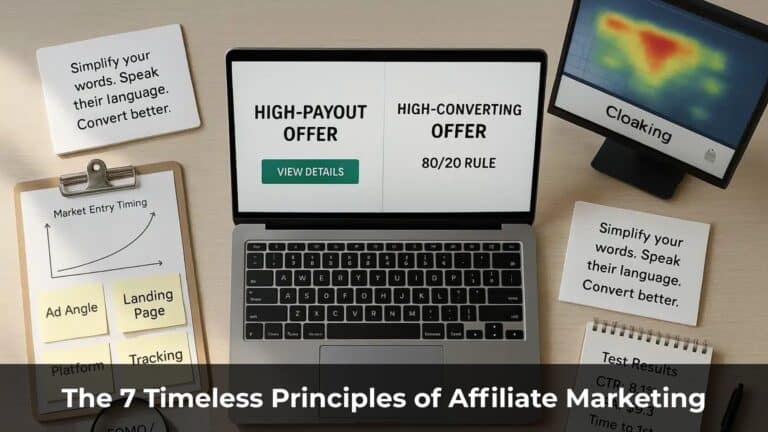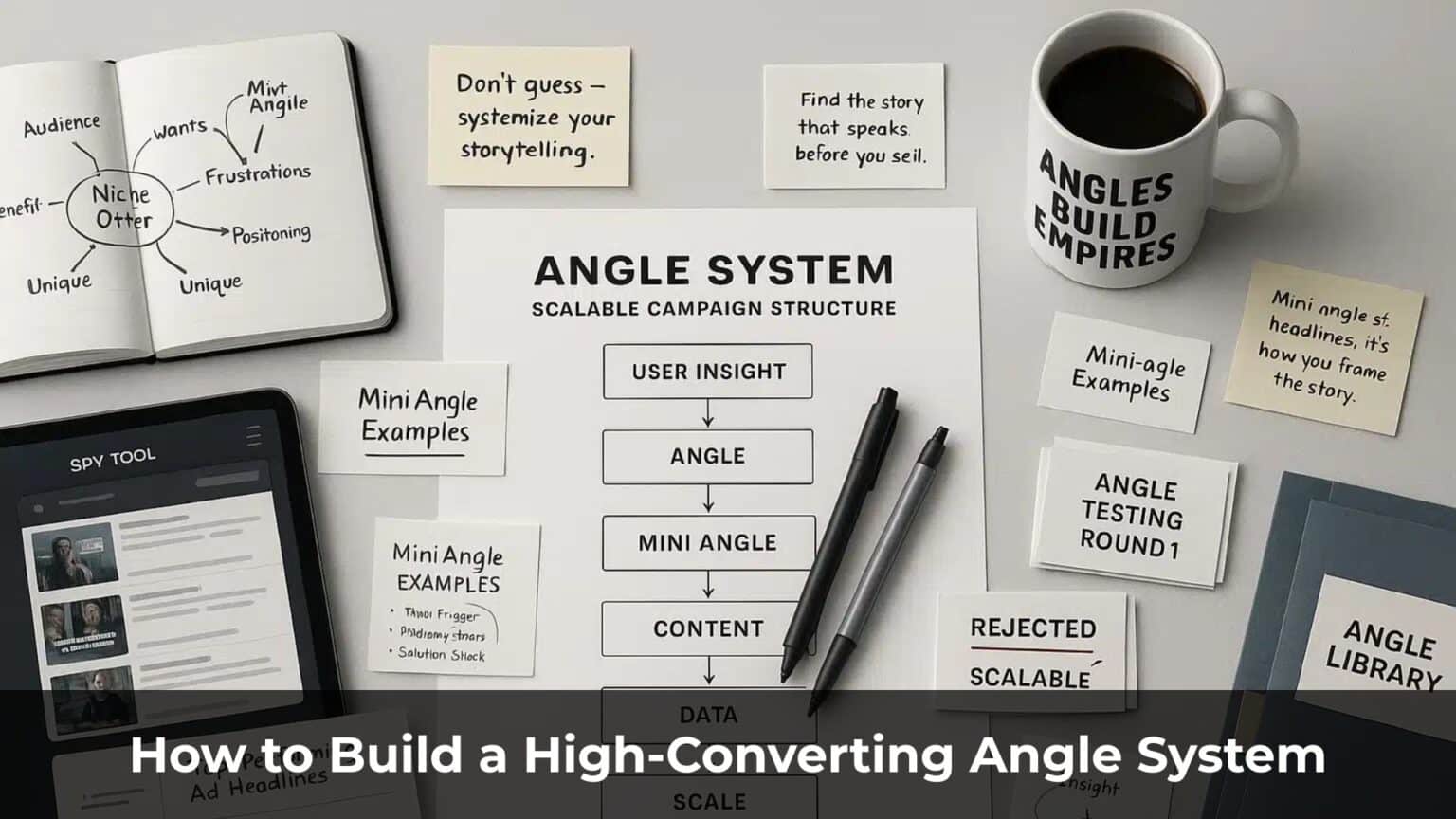You want to build a real Authority Site, right? Not just a blog, but a sustainable asset that pulls in consistent organic traffic and generates reliable income through SEO.
Too many marketers chase shortcuts. They think cranking out endless articles, stuffing keywords like it’s 2010, or letting AI blindly generate content is the answer. They jump into the content game without understanding what actually works today.
The predictable result? Websites stuck in the Google sandbox, traffic that never takes off, and the dream of passive income from SEO fading away.
Let’s cut the BS: In today’s SEO landscape, content isn’t just king – it needs to be the undisputed emperor, backed by genuine E-E-A-T (Experience, Expertise, Authoritativeness, Trustworthiness).
Shallow articles, thin content lacking real-world scars and insights? They get ignored by users and eventually slapped down by Google.
Building a true Authority Site isn’t a quick hack; it’s a strategic commitment. It demands serious investment in content quality, yes, but more fundamentally, it requires you to become a legitimate expert in your niche.
This guide lays out the blueprint. Forget the fluff. I’m sharing the core strategies and battle-tested methods you need to create high-caliber content that genuinely satisfies Google’s E-E-A-T standards.
We’re not looking for loopholes; we’re building a rock-solid foundation for your Authority Site to maximize long-term SEO wins.
Table of Contents
ToggleStep 1: Why Becoming the Expert Is the Core of Any E-E-A-T Content Strategy
I hear it constantly: “How do I write amazing content? How can I get AI to write amazing content for me?”
My answer never changes. It starts here: You absolutely must become a genuine expert in your field first.
This isn’t motivational fluff. It’s the non-negotiable prerequisite for creating content that delivers real value, earns Google’s algorithmic respect, and builds unwavering reader trust.
You’re building an Authority Site, remember? That means you are the authority.
Don’t fall for the fantasy of letting AI completely replace you, especially if your own knowledge foundation is shaky. AI is an incredibly powerful tool, an assistant – but it cannot replicate deep human experience and nuanced understanding.
Why is this the bedrock?
Experience is Your Unfair Advantage (The ‘E’): Anyone can regurgitate theory. What truly differentiates you are the insights forged in the trenches – the hard lessons, the practical workarounds, the solutions born from doing.
A real expert offers perspectives no AI can generate. That’s Experience.
You Set the Quality Bar: You want AI to write “great” content? What does “great” even mean in your niche if you don’t have the expertise to judge?
How can you possibly know if AI output is accurate, insightful, or truly helpful without deep domain knowledge? How can you guide it beyond surface-level summaries?
Expertise Fuels Effective AI Prompts: Garbage in, garbage out applies doubly to AI. To get high-quality results, you need to provide high-quality, specific prompts.
This requires understanding your topic deeply, articulating your goals clearly, and knowing precisely what information the AI needs. Only an expert can command an AI with this level of precision.
Becoming an expert isn’t an overnight process. It demands relentless learning, hands-on practice, staying current, and accumulating those invaluable real-world battle scars.
Invest the time and effort. It’s the single most critical investment you can make in building an Authority Site powered by content that truly meets the E-E-A-T standard.
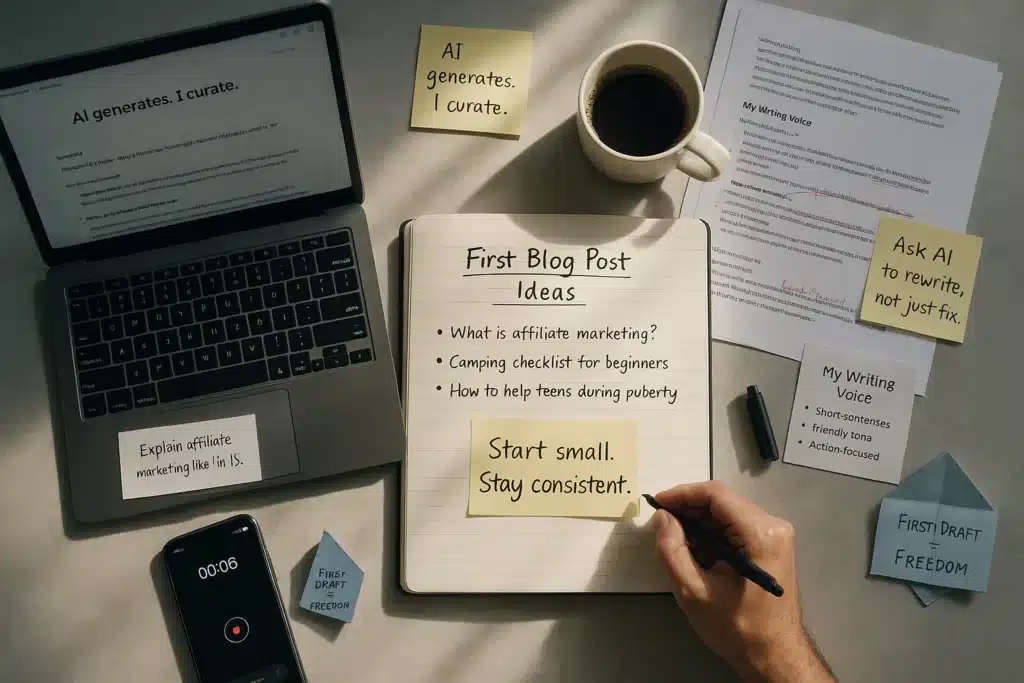
Step 2: Start Writing – Build Skill and Leverage AI Smartly
Expertise is the foundation. Now, you need to translate that knowledge into compelling, high-quality content. This means honing your writing skills and, crucially, learning to collaborate effectively with AI – using it as a force multiplier, not a crutch.
Feeling intimidated if writing isn’t your strong suit? Don’t be. Start where you are. Practice consistently. Focus on foundational topics before tackling complex ones.
Here’s a practical breakdown:
If You’re Still Developing Your Writing Chops:
Start with what you know best. Write clear, concise overview articles. Explain fundamental concepts. Answer the basic questions your audience asks.
Simpler Starting Points (Examples):
- Affiliate Marketing Explained: A No-Nonsense Guide for Beginners.
- Understanding Teen Development: What Every Parent Should Know.
- Camping 101: The Essential Gear Checklist for Your First Trip.
As You Progress (More Complex Examples):
- How to Skyrocket Landing Page Conversions for Cold Ad Traffic.
- Fostering Independent Learning in Children (Without the Pressure Cooker).
- DIY Guide: Building a Reliable Natural Water Filter for Backcountry Camping.
See the progression? Start foundational, then build depth.
Experiment with AI writing assistants. Tools can help draft sections, analyze style, or even suggest structural improvements. (Focus on reputable, current tools – the landscape changes fast).
Critical Point:NEVER blindly accept or publish AI-generated text. EVER. You are the expert-in-charge. The AI is your intern.
Review rigorously. Fact-check relentlessly. Inject your unique voice, insights, and experiences. Ensure the final piece reflects your authority, not the AI’s best guess.
If You’re Already a Confident Writer:
Advanced models like ChatGPT Plus (or equivalents) offer significant advantages in understanding nuance and generating sophisticated text.
“Tune” your AI assistant. Feed it examples of your strongest writing. Ask it to analyze your tone, sentence structure, vocabulary, and overall style, then instruct it to emulate that style in its drafts.
This makes the output feel significantly more authentic.
Direct AI Revisions with Precision:
When an AI draft misses the mark, don’t settle for vague commands like “rewrite this.” Be specific. Be strategic.
Weak Prompt: “Make this paragraph better.”
Stronger Prompts:
- “This section lacks practical application. Add a concrete, step-by-step example illustrating how a user can implement this technique.”
- “Reframe this argument from the perspective of a small business owner, focusing on the ROI implications.”
- “The language here is too passive and academic. Rewrite it using a more direct, active voice and simpler terms.”
This level of detailed feedback guides the AI effectively, producing results closer to your vision and saving you endless cycles of frustrating revisions.
Mastering this human-AI collaboration takes practice. Be patient. Experiment. Learn from each iteration. You’ll gradually forge a powerful workflow that blends your expertise with AI’s efficiency.
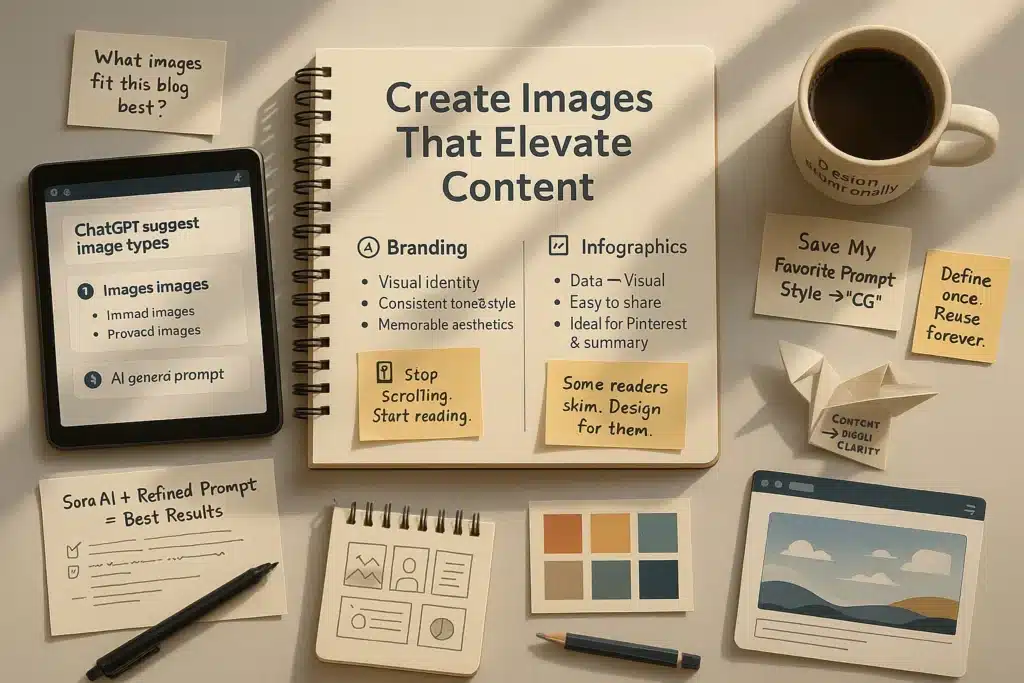
Step 3: Visual Strategy – Making Content Engaging and Digestible
Great writing is fundamental, but let’s face it: we live in a visual world. Walls of unbroken text are intimidating and ineffective online. A smart visual strategy is essential for creating E-E-A-T content that truly connects.
Don’t treat images as decoration. They serve critical functions:
- Brand Consistency & Professionalism: Unique, high-quality visuals (custom graphics, branded templates, relevant photos – not just generic stock) reinforce your brand identity and signal professionalism. Your visuals should feel cohesive and authoritative.
- Boosting Engagement & Reducing Friction: Images break the monotony of text, making content feel more approachable and easier to scan. Compelling visuals grab attention, illustrate key points, and can dramatically increase reader dwell time.
- Clarifying Complexity (Infographics & Diagrams): Sometimes, a picture is worth a thousand words. Use infographics, charts, diagrams, or even simple annotated screenshots to explain complex data, processes, or comparisons far more effectively than text alone.
Using AI for Image Creation (Thoughtfully):
AI image generators (Midjourney, DALL-E, etc.) can be fantastic for creating unique conceptual illustrations or custom graphics where stock photos fail.
- Define the Purpose: What should the image achieve? What concept does it need to illustrate? What style fits your brand?
- Prompt with Detail: Guide the AI with specifics: subject, style (photorealistic, cartoon, abstract), composition, color scheme, mood.
- Iterate: Expect to generate multiple options and refine your prompts. Perfect results rarely happen on the first try.
- Ensure Cohesion: Does the AI image fit your site’s overall look and feel?
- Add Real Value: Does the image clarify, enhance, or make the content more engaging? Or is it just filler? Be honest.
Just like with text, AI image generation needs your expert direction and critical eye. Use it to enhance your unique message, not as a substitute for a coherent visual strategy.

Step 4: Natural Keyword Optimization – Serve the Reader, Not Just the Bot
Okay, let’s tackle SEO keywords. Yes, they matter. But how you use them has changed dramatically.
Forget keyword stuffing. Jamming terms unnaturally into your content is a relic of the past. It creates a terrible reader experience and is more likely to earn you a Google penalty than a top ranking today.
Google’s smarter. Readers are definitely smarter. They crave natural, helpful, high-value content – not keyword-salad nonsense.
So, how do you optimize for an Authority Site in the E-E-A-T era?
The Golden Principle: Optimize naturally. Always prioritize the reader experience.
Here’s the game plan:
1. Research Intent, Not Just Keywords: Dig deeper than surface-level terms. Understand the why behind the search.
What specific problem is the user trying to solve? What information do they truly need?
Use SEO tools to uncover primary keywords, relevant long-tail variations (specific, multi-word phrases), and LSI keywords (terms semantically related to your topic).
2. Write for Humans, First and Foremost: Craft content that’s clear, logically structured, easy to scan, and genuinely solves the reader’s problem or answers their question thoroughly.
Use simple, direct language. Avoid unnecessary jargon.
3. Integrate Keywords Naturally: Weave your primary keyword and key variations into important on-page elements where they make sense contextually:
- Title Tag (Crucial!)
- Meta Description
- URL Slug
- Main Heading (H1)
- Relevant Subheadings (H2s, H3s)
- Introduction & Conclusion
- Image file names and Alt Text
- Naturally within the body paragraphs.
The Caveat: Never, ever force a keyword if it sounds awkward or compromises clarity. It’s better to omit a keyword instance than to create a clunky sentence that alienates the reader.
Forget rigid keyword density targets – that’s outdated thinking. Focus on comprehensive topic coverage and natural language.
Embrace Topic Clusters: Shift from optimizing single pages for single keywords to building topical authority. Create cornerstone “pillar” pages covering broad topics comprehensively.
Then, create detailed “cluster” articles addressing specific subtopics, linking them strategically back to the pillar and to each other.
This structure signals deep expertise to Google and provides a much better, more organized experience for your readers.
Remember: The goal isn’t to manipulate Google’s algorithm. It’s to clearly signal what your high-value content is about, so the right readers can easily find it when they search.
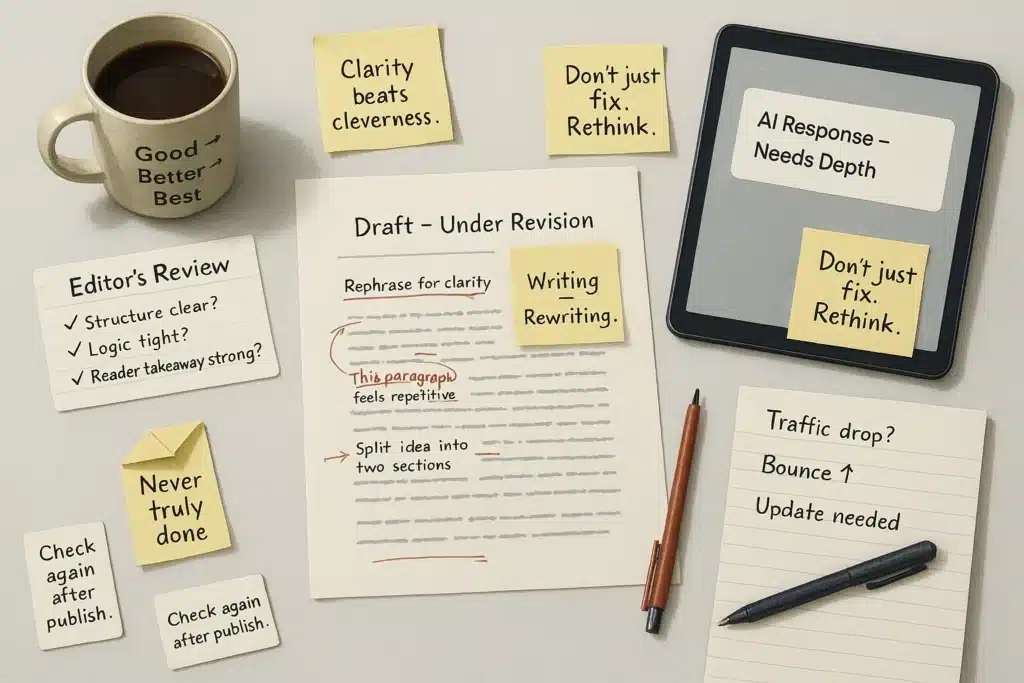
Step 5: The Editing Gauntlet – Where Good Content Becomes Great
Hitting “save” on that first draft? That’s not the finish line; it’s the starting gun for the real work: rigorous editing and refinement.
Too many marketers treat editing as a quick spell-check. They rush to publish, ignoring awkward phrasing, logical flaws, or missed opportunities to add depth. This sloppiness kills credibility and handicaps SEO potential.
Internalize this: Exceptional, authoritative content is almost never born in a single draft. It’s forged through multiple passes of critical review, thoughtful revision, and a relentless pursuit of clarity and impact. This iterative process is non-negotiable.
When editing (especially drafts involving AI), put on your most critical hat:
- Beyond Typos: Look past surface errors. Read the piece aloud. Does it flow well? Is the tone consistent? Does it sound like you (or your established brand voice)?
- Structural Integrity: Is the logic sound? Does each section build effectively on the last? Are transitions smooth or abrupt? Is anything redundant, missing, or out of place?
- The Reader’s Lens: Forget you wrote it. Read as if you’re the target audience encountering this for the first time. Is it genuinely easy to understand? Does it directly answer the implied question or solve the stated problem? Does it provide actionable value? Is it engaging, or does it feel like a chore to read?
- Refining AI Input (Strategic Guidance): If AI-assisted sections feel generic or weak, provide targeted feedback (as discussed in Step 2). Guide the revision: “This explanation needs a compelling statistic or a brief case study to add weight,” or “Strengthen the conclusion of this section by summarizing the key takeaway for the reader.”
- Living Content (Update & Refresh): Your job isn’t done at publication. Information gets outdated. Monitor your content’s performance.
Revisit key articles periodically. Is the information still 100% accurate? Can it be improved with new data, examples, or insights? Are there broken links? Treat your best content as living assets that require ongoing care.
This dedication to continuous improvement is what separates true Authority Sites from the vast sea of mediocre content farms.
It demonstrates commitment to quality for both users and search engines. Don’t view editing as a chore; see it as the crucial stage where you polish your expertise into a truly valuable resource.
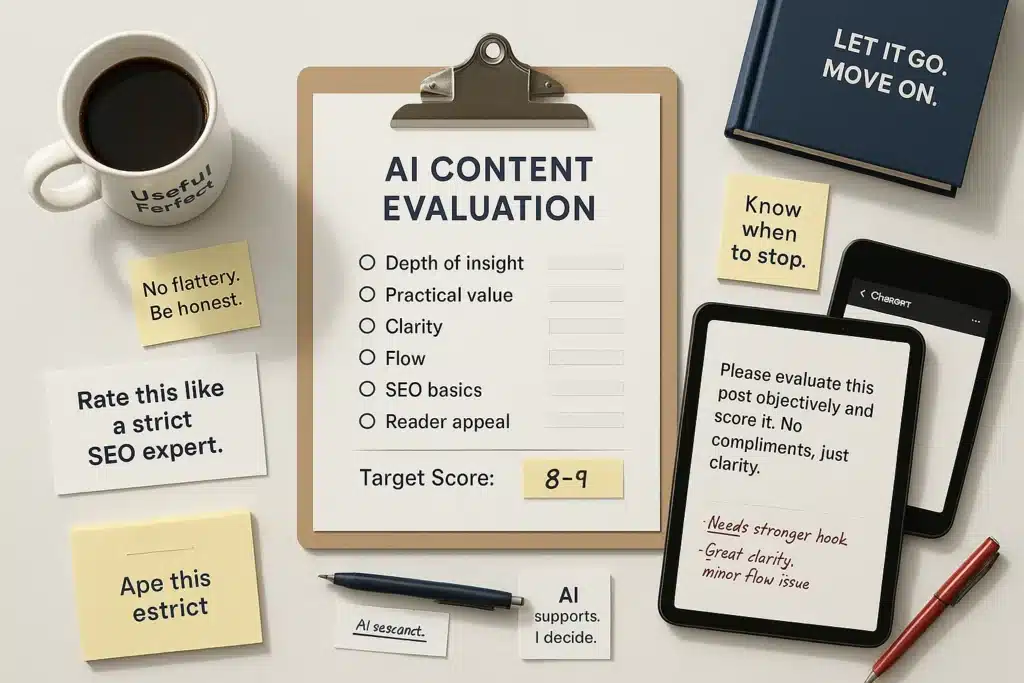
Step 6: Seeking Objective Feedback (AI Can Help, If Used Wisely)
After self-editing, an outside perspective is gold. While feedback from trusted peers or mentors is ideal, you can use AI for a structured initial critique – but you need to be smart about it.
Avoid the perfectionist trap: endlessly asking AI to “improve this” without specific goals. That’s a recipe for frustration and wasted time.
Reality Check: 100% perfect content doesn’t exist. If you keep asking AI for vague improvements, it will always find something to change, often leading you down pointless paths.
Instead, use AI for targeted evaluation:
- Assign a Role & Criteria: Don’t ask, “Is this good?” Instruct the AI: “Act as a highly critical editor for an expert marketing blog. Evaluate this article strictly based on: 1) Depth of practical insight, 2) Clarity and flow, 3) Actionability of advice, 4) Demonstration of E-E-A-T, 5) Overall reader engagement. Score it from 1-10 on each criterion.”
- Demand Critical Honesty: Be explicit: “Provide brutally honest, objective feedback. Do not focus on praise. Pinpoint the 1-2 biggest weaknesses or areas for improvement based on the criteria above.”
- Recognize Diminishing Returns (Know When to Stop): If the article scores well against your defined criteria (say, consistently 8+) and you genuinely feel it delivers strong value, trust your judgment. Don’t get bogged down chasing minor AI suggestions for an imaginary perfect score. Perfectionism is the enemy of progress.
AI feedback is a data point, not the final word. Combine its structured critique with your own expert judgment. You are the ultimate arbiter of quality. Use the feedback to catch blind spots, then move forward confidently.
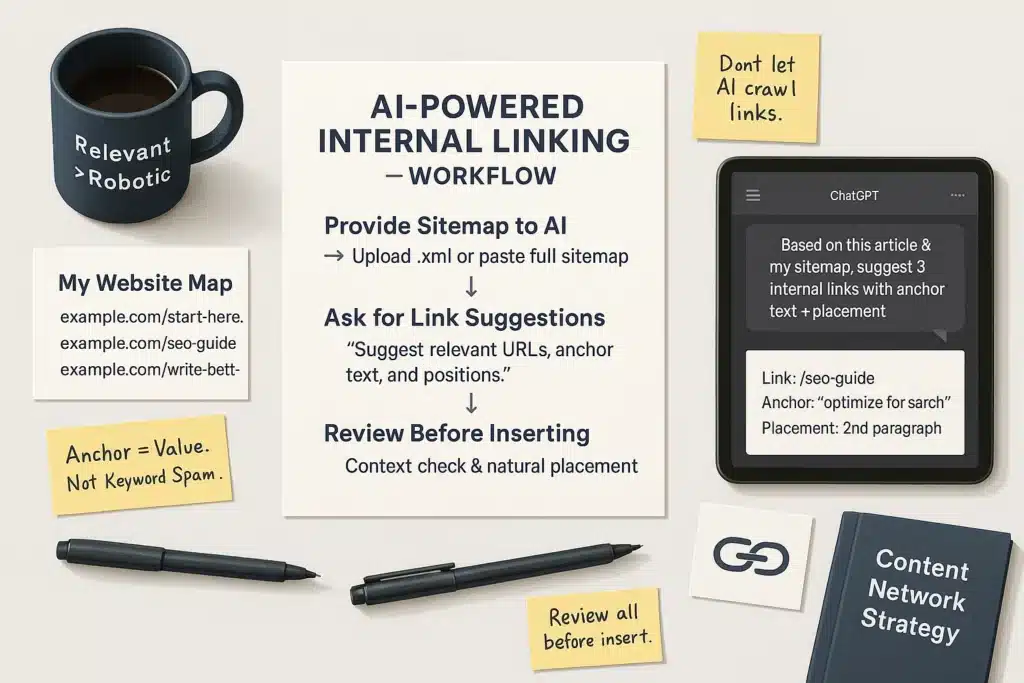
Step 7: Strategic Internal Linking – Weaving Your Web of Authority
Internal linking – connecting relevant pages within your own site – is fundamental for SEO and user experience. It helps Google crawl and understand your site’s structure, spreads link equity (ranking power), and guides readers towards related content, keeping them engaged and demonstrating your topical breadth.
Manually finding the best internal linking opportunities across dozens or hundreds of articles is a tedious nightmare.
AI can be a game-changer here.
Leverage AI to systematically identify contextually relevant linking opportunities:
1. Feed AI Your Site Structure (Sitemap): To make relevant suggestions, the AI needs to know what content exists on your site.
Providing your sitemap.xml (either by uploading the file or pasting its content) is often the most efficient way. This gives the AI a bird’s-eye view of your URLs and topics.
2. Request Links After Drafting: Once your new article is drafted, give the content and the sitemap context to your AI. Ask for specific suggestions.
Effective Prompt:
"Analyze this new article draft. Based on my provided sitemap, identify 3-5 existing articles on my site that are highly relevant to link to from this new piece. For each suggestion, specify the target URL, the most appropriate anchor text within the new article, and the paragraph where the link should ideally be placed."
Ensure the AI understands it should suggest links from the new article to existing ones, not the other way around, and not just link to the sitemap page itself.3. Implement with Human Oversight: Use the AI’s suggestions as a starting point. Find the proposed anchor text in your draft and insert the links.
Crucially, review every single suggestion. Is the link genuinely relevant in that specific context? Does the anchor text accurately describe the linked page?
Does the linked page truly add value for someone reading that part of your new article? If not, discard the suggestion. Your judgment overrides the AI.
- Schedule Periodic Linking Audits: Internal linking isn’t set-it-and-forget-it. As you publish new content, revisit relevant older articles to link to the new ones.
Periodically (e.g., quarterly), you can use AI with an updated sitemap to identify new cross-linking opportunities across your entire site, continually strengthening your topical clusters.
By blending AI’s speed with your strategic editorial judgment, you can build and maintain a powerful internal linking structure far more efficiently, boosting both SEO and user navigation.
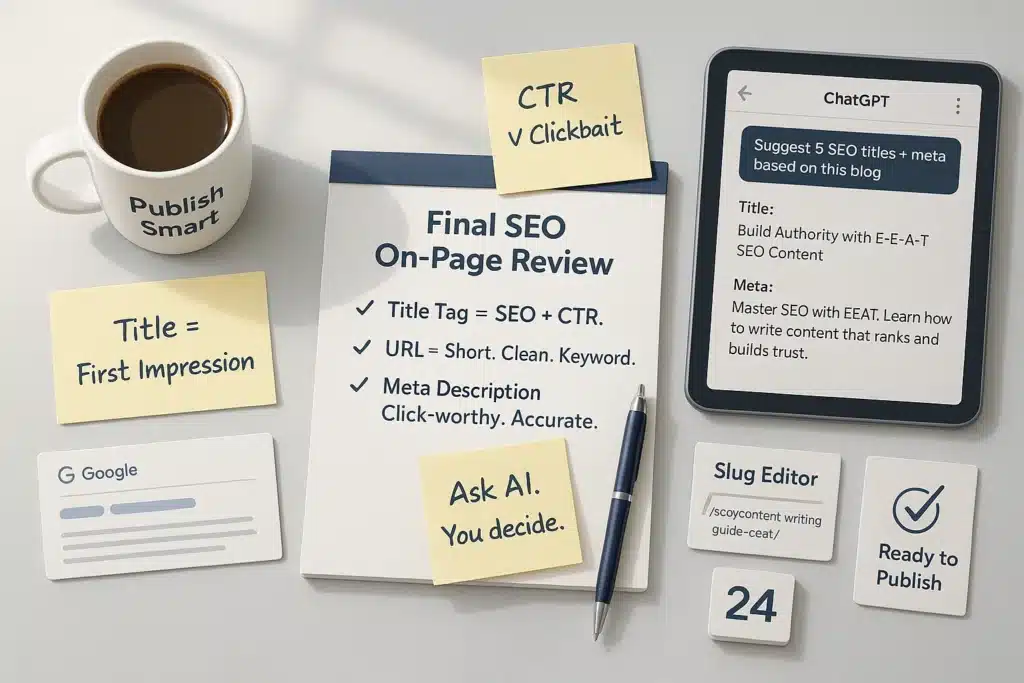
Step 8: The Final On-Page Polish – Pre-Flight Checks for SEO
The core content is strong, edited, and linked. Before launching, run through these final on-page SEO checks. These details significantly impact how your article appears in search results and whether users click.
1. Nail the Title Tag: This is arguably your most potent on-page SEO lever. It heavily influences rankings and SERP click-through rates (CTR).
Objective: Craft a compelling title (ideally under 60 characters) that includes your primary keyword naturally, clearly signals the article’s core value, and creates curiosity or urgency.
AI Brainstorming:
"Based on this final article, generate 5 distinct, compelling Title Tag options optimized for SEO (using keyword '[Your Keyword]') and high CTR on Google."Your Choice: Review AI suggestions, mix with your own ideas, and select the absolute strongest one. Often, slightly modifying an AI suggestion works best.
2. Craft a Clean, Descriptive URL Slug: Keep it short, user-friendly, and include the primary keyword.
Best Practice: Use hyphens, lowercase, omit stop words (like ‘a’, ‘the’, ‘is’). (e.g., /eeat-content-strategy-seo-authority/).
AI Assist:
"From my chosen title '[Your Final Title]', create a short, SEO-friendly URL slug."3. Write a Magnetic Meta Description: While not a direct ranking factor, this is your sales pitch on the SERP. It dictates whether users click your result.
Objective: Summarize the article’s key benefit/solution concisely (under 160 characters), include the primary keyword naturally, and implicitly encourage a click.
AI Drafting:
"Using my title '[Your Final Title]' and the article's core message, write a compelling meta description (under 160 characters) including the keyword '[Your Keyword]' that highlights the main benefit and motivates users to click."Example Refined: “Unlock lasting SEO authority with a proven E-E-A-T content strategy. Learn to create content Google trusts & ranks high. Get your step-by-step blueprint now!”
Conclusion: Authority is Built, Not Bought
Building a truly authoritative website that dominates SEO long-term isn’t about discovering secret hacks or gaming the system. It’s about a fundamental commitment: becoming a genuine source of expertise and consistently delivering outstanding value.
Mastering E-E-A-T isn’t just about checking Google’s boxes; it’s about earning genuine reader trust.
When you focus on demonstrating real Experience, showcasing deep Expertise, building solid Authoritativeness, and proving unwavering Trustworthiness through meticulously researched, insightful, and clearly presented content, you build an asset that withstands algorithm updates.
Use tools like AI as powerful levers, optimize with the reader always in mind, edit with a critical eye, and never stop learning. Focus relentlessly on serving your audience with content that solves their problems and answers their questions better than anyone else.
That’s how you build more than just a website – you build a respected authority, the foundation of sustainable online success.




